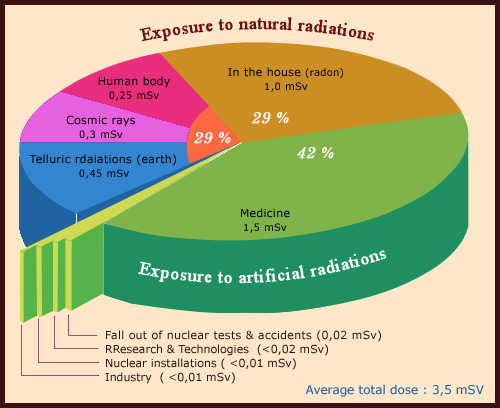A chronic but benign exposure

Average breakdown of radiation exposure in France
According to this repartition, the total dose is around 3.5 mSv : natural radiation making up 2 mSv and artificial radioactivity making up 1.5 mSv. The natural exposure is primarily due – 60% – to radon. The artificial exposure can be traced back to medical examinations and treatment, with industry and research only contributing 1%. It is important to remember that these values are averages.
© IN2P3
All exposure to radioactivity, whether natural or artificial, is measured in doses which take into account the biological effect the radiation can have. This is the effective dose, which has one given value for the whole body. For small amounts of radiations, the relevant unit is the thousandth of a sievert or millisievert (mSv).
In a country like France or Belgium, the annual dose is calculated to be around 3.5 mSv per person in this first decade of the 21st Century. One hundred years ago that value would have been at 2.4 mSv. This rise is largely due to the development of radiation techniques in medicine; as the doses of natural exposure have undergone no variation.
The high dose of radiation one receives in a medical scan is applied over a very short period of time. Exposure to natural radioactivity, however, is permanent. Spread over a period of days, months, years or decades, the chronic dose we absorb is fortunately comparatively low. The long time periods over which the absorption takes place also allows the cells of our body to repair the damage they undergo as a result.
Natural radiations come from a variety of sources: the telluric radiations emitted by rocks (0.45 to 0.54 mSv), cosmic rays (0.30 to 0.36 mSv), from the body own radioactivity (0.25 to 0.30 mSv) and, most significantly, from radon gas (1.0 to 1.2 mSv) – a radioactive descendant of uranium which escapes from the rocks around us. Ranges are given rather than precise values because measurements of exposure levels vary depending on the body that carried them out or the period in which the tests were conducted.
Radon and its radioactive decay products are the principal contributors to the natural radioactivity we absorb. The radioactivity of the human body is mainly caused by the presence of two natural radioisotopes; potassium 40 and carbon 14 (which undergoes 8,000 disintegrations per second).
Apart from exposure to radon gas, which can, to some degree, be reduced, the value of natural radioactivity is invariant.
In France, natural exposure is responsible for an average dose of 2 mSv. Apart from our body own radioactivity, the ratios of the other sources can vary dramatically depending on where we live in the world – without having to go the extremes of astronauts who absorb greater doses of cosmic rays or villagers in Kerala, who have greater exposure to telluric rays.
NEXT : Cosmic rays
NEXT : Radioactivity from ground
NEXT : Internal exposures
Other articles on the subject « Natural Radioactivity »
Natural Origins
From vestiges of earth formation to cosmic rays Despite having evolved under constant exposure to[...]
Uranium and thorium origins
Radioactive substances older than the Earth The principal source of natural radiations on Earth i[...]
Cosmogenic Radioelements
Formation of radioactive atoms from cosmic rays The Earth is constantly being bombarded by ‘[...]
Ground Radioactivity
Telluric Exposure : Radiation which emanates from rocks The Earth crust contains a number of radi[...]
Human Internal Exposure
Our bodies are also… slightly radioactive All through our lives, we inhale and ingest radio[...]
Radioactivity in food
In our glasses and on our plates … The very acts of breathing and walking around make it im[...]